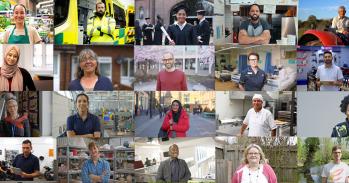
The UK’s fastest academic supercomputer, based at the University of Cambridge, will be made available to artificial intelligence (AI) technology companies from across the UK, in support of the government’s industrial strategy.
The UK’s fastest academic supercomputer, based at the University of Cambridge, will be made available to artificial intelligence (AI) technology companies from across the UK, in support of the government’s industrial strategy.
Cambridge’s supercomputer provides researchers with the fast and affordable supercomputing power they need for AI work.
Paul Calleja
The new AI supercomputer is a £10 million partnership between the Engineering and Physical Sciences Research Council (EPSRC), the Science and Technology Facilities Council (STFC) and the University. Capable of solving the largest scientific and industrial challenges at very high speeds, the supercomputer is supported by Cambridge’s Research Computing Service. The aim is to help companies to create real business value from advanced computing infrastructures.
The supercomputer is part of the UK government’s AI Sector Deal, which involves more than 50 leading technology companies and organisations. The deal is worth almost £1 billion, including almost £300 million of private sector investment into AI.
“AI research requires supercomputing capacity capable of processing huge amounts of data at very high speeds,” said Dr Paul Calleja, Director of the University’s Research Computing Service. “Cambridge’s supercomputer provides researchers with the fast and affordable supercomputing power they need for AI work.”
In addition to computing power, Calleja and his team will provide training, guidance and support Cambridge researchers, and the wider UK IA industry, to make the most of their data.
“AI projects involving Cambridge researchers are already underway,” said Calleja. “In the life sciences we are working on medical imaging analysis and genomics, and in astronomy, AI is being used as part of the Square Kilometre Array project and research to map exoplanets.”
Cambridge is home to the largest technology cluster in Europe. Over the past decade, start-ups based on AI and machine learning, in Cambridge and elsewhere, have seen explosive growth.
“The UK must be at the forefront of emerging technologies, pushing boundaries and harnessing innovation to change people’s lives for the better,” said Secretary of State for Digital, Culture, Media and Sport Matt Hancock. “Artificial Intelligence is at the centre of our plans to make the UK the best place in the world to start and grow a digital business. We have a great track record and are home to some of the world’s biggest names in AI like Deepmind, Swiftkey and Babylon, but there is so much more we can do. By boosting AI skills and data-driven technologies we will make sure that we continue to build a Britain that is shaping the future.”
Building on the commitment made in the government’s modern Industrial Strategy and its AI Grand Challenge, the AI Sector Deal marks the first phase of a major innovation-focused investment drive in AI which aims to help the UK seize the £232 billion opportunity AI offers the UK economy by 2030 (10% of GDP).
The deal will help establish the UK as a research hotspot, with measures to ensure the innovators and tech entrepreneurs of tomorrow are based in the UK, with investment in the high-level post-graduate skills needed to capitalise on technology’s huge potential.
It includes money for training for 8,000 specialist computer science teachers, 1,000 government-funded AI PhDs by 2025 and a commitment to develop a prestigious global Turing Fellowship programme to attract and retain the best research talent in AI to the UK.
“Artificial intelligence provides limitless opportunities to develop new, efficient and accessible products and services which transform the way we live and work,” said Business and Energy Secretary Greg Clark. “Today’s new deal with industry will ensure we have the right investment, infrastructure and highly-skilled workforce to establish the UK as a driving force in the development and commercial use of artificial intelligence technologies.”

The text in this work is licensed under a Creative Commons Attribution 4.0 International License. For image use please see separate credits above.




